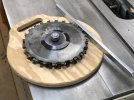I've recently purchased my first dado stack. It's a Ridge Carbide 8 inch set. I happily put together my first blade assembly per their instructions with the outside plates and four of the 1/8in chippers to make a 3/4in test cut. My cut came out ~0.050 wide. I was expecting it to cut either dead on or slightly under. I wouldn't have been surprised if it was off 0.005 or so, but over a 32nd seems odd.
I started measuring things last night. It appears that the chippers all have thicknesses from 0.125 to 0.127 at their thickest portions. There is a smoother "hub" area at the center of each chipper that is ~0.002 thinner than the 4 arms. The plates on the ends are of the correct thickness and geometry to generate the proper 1/8in cut. (The plate is 0.110 and the tooth is ~0.142 wide.) Soooo ... to me, this means that I should expect the stack to end up perhaps ~0.006 wider than 3/4in. I measured runout using a dial indicator, and I get around 0.0025 TIR just below the teeth, which seems pretty sane.
So here's where things seem to get weird:
If I place the stack on the bench and measure from the bench to the tip of the outside carbide tooth (using a gage block), the stack height seems to be as I expect - just a tiny bit over 0.750. However, when I put the stack in the saw and firmly tighten the arbor nut, it seems to expand and cut ~0.050 wide! If I set the arbor nut as loose as I dare and run another test cut, it now appears to cut ~0.016 wide.
Does anyone have any idea what is going on? Are the outer plates really "cupping" outward when I clamp the stack on the arbor and throwing things out this much!!?? Since the inner "hubs" of the chippers are thinner than the outer portions, perhaps this is possible? Is this normal for a dado stack?
Any and all input greatly appreciated!
I started measuring things last night. It appears that the chippers all have thicknesses from 0.125 to 0.127 at their thickest portions. There is a smoother "hub" area at the center of each chipper that is ~0.002 thinner than the 4 arms. The plates on the ends are of the correct thickness and geometry to generate the proper 1/8in cut. (The plate is 0.110 and the tooth is ~0.142 wide.) Soooo ... to me, this means that I should expect the stack to end up perhaps ~0.006 wider than 3/4in. I measured runout using a dial indicator, and I get around 0.0025 TIR just below the teeth, which seems pretty sane.
So here's where things seem to get weird:
If I place the stack on the bench and measure from the bench to the tip of the outside carbide tooth (using a gage block), the stack height seems to be as I expect - just a tiny bit over 0.750. However, when I put the stack in the saw and firmly tighten the arbor nut, it seems to expand and cut ~0.050 wide! If I set the arbor nut as loose as I dare and run another test cut, it now appears to cut ~0.016 wide.
Does anyone have any idea what is going on? Are the outer plates really "cupping" outward when I clamp the stack on the arbor and throwing things out this much!!?? Since the inner "hubs" of the chippers are thinner than the outer portions, perhaps this is possible? Is this normal for a dado stack?
Any and all input greatly appreciated!

